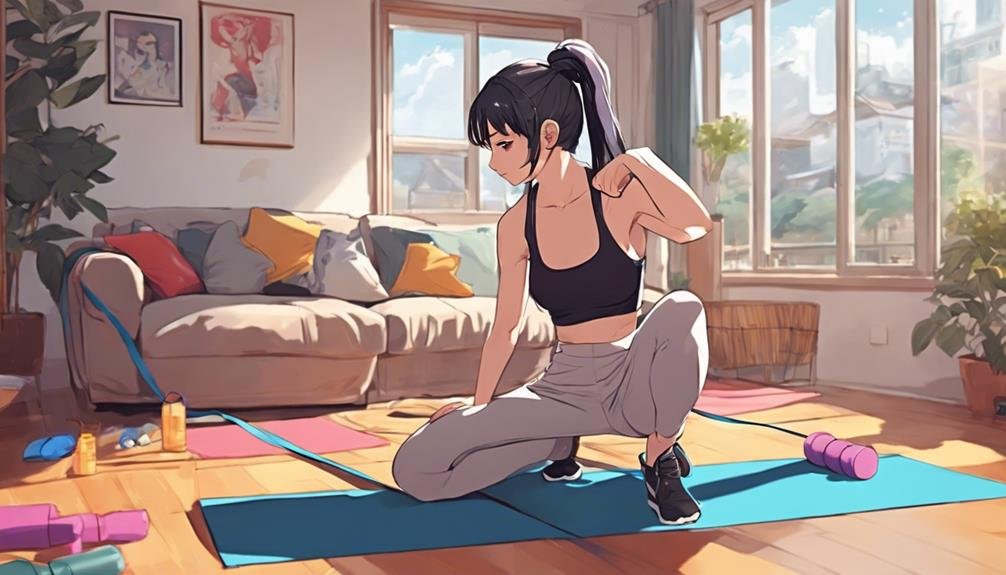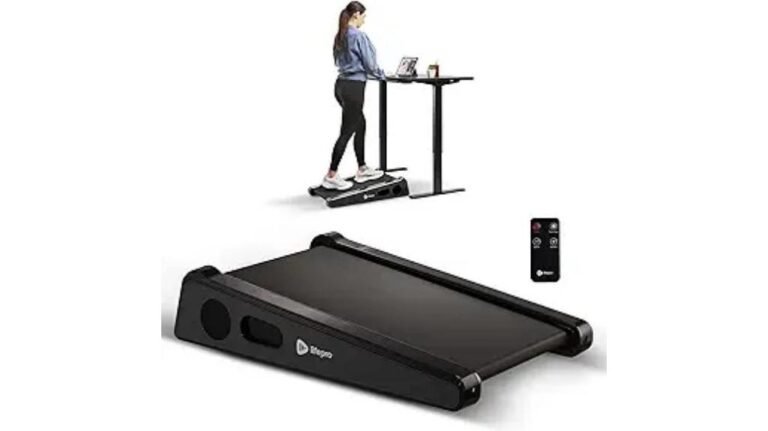Beginner's Guide to Functional Fitness at Home
Embarking on your journey into functional fitness at home might seem like a daunting task, requiring a complete overhaul of your living space and routine. However, fear not, as the path to enhancing your physical well-being can be simpler than you think.
By understanding the core principles of functional fitness and making strategic choices, you can efficiently kickstart your progress without feeling overwhelmed. Curious to know how a few small adjustments can lead to significant gains in your fitness journey?
Let's explore how you can seamlessly integrate functional fitness into your daily life.
Key Takeaways
- Create a dedicated workout space with proper lighting and ventilation for effective functional fitness.
- Equip your home gym with versatile essentials like dumbbells and resistance bands for varied workouts.
- Organize storage efficiently to keep equipment accessible and maintain a clutter-free workout area.
- Focus on functional movements that enhance strength, agility, and mobility for daily activities.
Benefits of Functional Fitness
Unlock the numerous advantages of functional fitness and transform your daily life with strength, agility, and vitality. By incorporating functional fitness exercises into your routine, you can experience improved mobility and increased strength. Functional fitness focuses on movements that mimic everyday activities, making your body more efficient in performing tasks both inside and outside the gym.
Improved mobility is a key benefit of functional fitness. Through exercises that engage multiple muscle groups simultaneously, you enhance your body's ability to move freely and with ease. This increased range of motion not only helps in daily activities but also reduces the risk of injuries by improving joint stability.
Furthermore, functional fitness aids in boosting your strength levels. By incorporating movements that involve pushing, pulling, squatting, and rotating, you develop functional strength that's applicable to real-life situations. Whether it's lifting groceries or playing with your kids, the increased strength from functional fitness will make these tasks feel effortless. Incorporate these exercises into your routine to unlock a healthier, more capable version of yourself.
Understanding Functional Movements
Enhance your fitness journey by delving into the realm of functional movements, which are key to improving your overall strength and mobility. Understanding functional movement patterns and body mechanics is crucial for achieving optimal fitness results. Functional movements mimic everyday actions and involve multiple muscle groups working together, making them highly effective for improving your physical capabilities.
- Functional Movement Patterns: Focus on movements that replicate real-life activities.
- Engage Core Muscles: Emphasize the importance of stabilizing your core during exercises.
- Full Range of Motion: Perform exercises that allow your joints to move through their complete range.
- Balance and Stability: Work on exercises that challenge your balance and stability.
- Functional Strength: Develop strength that directly translates to your daily tasks.
Setting Up Your Home Gym
Ready to transform your living space into a powerhouse of health and strength?
Let's begin by choosing the perfect spot for your home gym, then we'll explore the essential equipment needed for effective workouts.
Finally, we'll dive into clever storage solutions to keep your space organized and clutter-free.
Let's get started on creating your ultimate home fitness sanctuary!
Selecting Workout Space
When creating your home gym, consider a space that's both functional and conducive to your fitness goals. To make the most of your home workout and ensure optimal space utilization, follow these tips:
- Clear Out Clutter: Remove unnecessary items to create a dedicated workout area.
- Good Lighting: Choose a space with ample natural light or add bright lighting to keep you energized.
- Ventilation: Ensure good airflow to keep the space fresh and comfortable.
- Mirrors: Consider adding mirrors to check your form and progress.
- Motivational Decor: Surround yourself with inspiring quotes or images to create an environment conducive to your fitness journey.
Essential Equipment Choices
For an effective home gym setup, prioritize selecting essential equipment that aligns with your fitness goals and maximizes your workout potential. Consider the available equipment space in your home when choosing items for your home workout. Opt for versatile equipment like dumbbells, resistance bands, and a stability ball to target different muscle groups and add variety to your routines.
A yoga mat can provide cushioning for floor exercises and stretching. If cardio is your focus, a jump rope or a stationary bike could be beneficial. Adjustable dumbbells are a great space-saving option that allows you to increase or decrease weight as needed. Invest in quality equipment that suits your needs and fits well within your designated workout area.
Organizing Storage Solutions
To optimize your home gym setup, efficient organizing storage solutions are key to creating a functional and inspiring workout space. When it comes to storage organization and space optimization, here are five essential tips to help you declutter and arrange your equipment effectively:
- Invest in versatile storage units: Look for shelves, racks, or bins that can hold different types of equipment.
- Use wall space wisely: Install hooks or wall-mounted racks to keep items off the floor and easily accessible.
- Label containers and shelves: This will make it easier to find what you need quickly.
- Create designated areas: Assign specific spots for different types of equipment to maintain order.
- Regularly review and rearrange: Keep the space dynamic by adjusting storage solutions as needed to accommodate new equipment or changes in your workout routine.
Essential Equipment for Beginners
Ready to kickstart your fitness journey at home? Discover the basic equipment needs, affordable options, and space-saving solutions that will help you get started on the right track.
Investing in the right tools can make all the difference in achieving your fitness goals without breaking the bank or sacrificing space in your home. Let's explore how you can set up your home gym for success!
Basic Equipment Needs
Get yourself set up with the essential equipment every beginner needs to kickstart your functional fitness journey at home. Here are the must-have items for your home workout and functional training:
- Resistance Bands: Versatile tools for strength training and mobility work.
- Dumbbells: Ideal for various exercises targeting different muscle groups.
- Yoga Mat: Provides cushioning and grip for floor exercises and stretching.
- Kettlebell: Great for dynamic movements and building strength.
- Jump Rope: Perfect for cardio workouts and improving coordination.
Having these basic pieces of equipment will allow you to perform a wide range of exercises to elevate your fitness level right from the comfort of your home. Start your journey today!
Affordable Options Available
Now, let's explore some affordable options for essential equipment that beginners can consider to kickstart their functional fitness journey at home. To stay within budget, look for budget-friendly equipment like resistance bands, a jump rope, or a stability ball. These items are versatile, effective, and won't break the bank.
You can also get creative with DIY workout options using household items like water bottles as weights, chairs for step-ups, or towels for slider exercises. Don't let the cost of equipment hold you back from achieving your fitness goals. With these affordable options and DIY alternatives, you can build strength, improve flexibility, and boost your overall fitness without spending a fortune.
Start your functional fitness journey today with these accessible choices.
Space-Saving Solutions
To maximize your workout space at home while still having essential equipment, consider investing in versatile and compact options like adjustable dumbbells or a foldable exercise bench. Creating a functional workout area doesn't require a large room; you can achieve a lot with a little creativity. Utilize wall-mounted storage or collapsible fitness gear to make the most of your space.
Here are some space-saving solutions for your home gym setup:
- Resistance bands with varying levels of intensity
- Suspension trainer for bodyweight exercises
- Yoga mat for floor work and stretching
- Kettlebells for full-body strength training
- Jump rope for cardiovascular workouts
With these compact exercise equipment options and a bit of ingenuity, you can transform even the smallest corner into a dynamic workout space.
Beginner-Friendly Functional Exercises
Start your journey towards improved functional fitness with these beginner-friendly exercises that will help you build strength and mobility. When starting out, focus on form correction and injury prevention.
Begin with bodyweight squats, ensuring your knees don't go past your toes and your back remains straight. Engage your core, breathe properly, and keep the movements controlled.
Push-ups are great for upper body strength and core engagement. Make sure your body forms a straight line from head to heels.
Planks are excellent for core stability; maintain a straight back and hold for as long as you can with proper breathing.
Lunges help with balance and leg strength, just be mindful that your front knee doesn't go over your toes.
Lastly, practice hip hinges with exercises like Romanian deadlifts to strengthen your posterior chain.
Progressing in Functional Fitness
Ready to take your functional fitness to the next level? As you continue on your fitness journey, progression techniques are key to keep challenging your body and seeing improvements. Setting clear goals will help you stay focused and motivated. Here are some tips to help you advance in your functional fitness routine:
- Gradually Increase Intensity: Challenge yourself by increasing the weight, repetitions, or difficulty of exercises over time.
- Incorporate Variety: Add new exercises or modify existing ones to target different muscle groups and prevent plateaus.
- Focus on Form: Ensure proper technique to maximize effectiveness and prevent injuries.
- Track Your Progress: Keep a workout journal or use fitness apps to monitor your improvements and adjust your routine accordingly.
- Prioritize Strength Building: Building strength is fundamental to functional fitness, so include exercises that target all major muscle groups.
Conclusion
Now that you have the basics down, remember that functional fitness is like a key that unlocks your body's full potential. Keep pushing yourself, trying new exercises, and challenging your limits.
With consistency and dedication, you'll soon be reaping the rewards of improved mobility, strength, and overall health. So don't give up, keep going, and watch as your body transforms into a powerhouse of functionality and strength.
You've got this!







